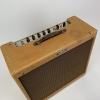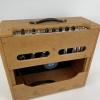Description
Please call/email for delivery slot and deposit details.
A good friend of mine, Northwest bluesman extraordinaire Sammy Eubanks, has been gigging with a 1960 5G9 Tremolux for years. I’ve always been a fan of his live tone, and decided to look into just what was going on under the hood of the 5G9 “Big Box” Tremolux. What I found was very interesting. The 5G9 was most likely the last Tweed era circuit before the Brownface era was ushered in during that latter part of 1959. It holds the distinction of being the only Tweed circuit with the “G” identifier, which is normally associated with the Brownface-era amps. Furthermore, it would seem that nobody has ever seen a 5G9 in the wild with a “5G9” tube chart. They all seem to have the predecessor’s 5E9-A tube chart. The only way to tell is to pull the rear panel or reach in and feel for the filter cap “doghouse” on the underside of the chassis
According to popular lore, a Tweed Tremolux is simply a 5E3 Deluxe with tremolo; au contraire. Yes, it does have the wonderfully quirky interactive first stage preamp that the 5E3 is known for. But the resemblance stops there. Unlike the 5E3, the 5G9 has no second gain stage (more on that later). As a result, the 5G9 has quite a bit of headroom before the onset of breakup. The 5G9 uses a long-tailed pair phase inverter and a power section borrowed from its big brother, the legendary 5F6-A Bassman. This gives the 5G9 a tighter bottom end that holds up long after the 5E3 starts to get “loose”. The 5G9 also used the higher voltage 5U4GB rectifier tube, compared to the 5E3’s saggier 5Y3GT.
So, is this just a clone of a 5G9? Nope. Here at Cutthroat Audio, we pay homage to the classics, and strive to preserve the DNA of the circuit at hand. But we do believe in adding features that can enhance the player’s experience by making the amp more versatile, while preserving a circuit’s original design and sonics. For example, many of the Tweed-era amps use a 12AY7 in the V1 position. This tube has a 40% gain factor compared to a 12AX7’s 100%. It has more headroom, breaks up much later, but sounds very sweet and smooth when pushed. A lot of modern takes on Tweed-era circuits will abandon the 12AY7 in favor of the 12AX7, which makes for a more aggressive tone with earlier breakup. And that’s not a bad thing. So instead of choosing one or the other, or perhaps splitting the difference with a 5751 (70% gain factor), the Fullerton™ 5G9 has a 12AY7 & 12AX7 available on the Bright channel, via a push/pull volume pot. The somewhat redundant Normal channel has been re-voiced using a JMP50 lead spec inspired preamp section, using a 12AX7, for a more British flavor. The push/pull volume pot on the Normal/JMP50 channel internally jumpers the JMP50 and 5G9 preamp sections for even more sonic possibilities.
I mentioned above the lack of a second gain stage on the stock 5G9. Well, with 1/2 of a 12AY7 sitting there unused, it just made sense to add one. So, a second gain stage was borrowed from the 6G3’s circuit, and made switchable on the push/pull tone pot. This moves it into 5E3 gain territory should the need arise. Like the 5E3, the 5G9 does not have a negative feedback loop. This accounts for the “hairy” tone of the 5E3 when pushed. Again, not a bad thing, but the Fullerton™ 5G9 has a NFB switch that lets you choose between 5G9 (none), 5F6-A (heavy) and 6G3 (moderate) NFB settings. Also added is a switch that lets you select the stock 5U4GB tube rectifier or solid state rectification. You can also use a GZ34 rectifier as well. When swapping rectifier tubes, a re-bias is necessary.
The Tweed Vibrolux and Tremolux were the first Fenders to have an on-board effect. The 5G9 uses a bias-vary tremolo, similar to what was used on the later 6G2, 6G3 and 6G11 Brownface amps. Unlike the Brownface brethren, the 5G9 needs a whole 12AX7 to do its thing, and the circuit has several differences. There are a couple of different component values in the tremolo section that I documented on my friend Sammy’s 5G9, as well as several on the web, that are not reflected on the Fender schematic or layout. These are likely running changes that Fender was know to make as circuits evolved during a production run. These differences have been incorporated into the Fullerton 5G9’s tremolo. I’ve also done done the tremolo mod that slows the speed down to a much more usable level. At low speed settings the tremolo speed is way too fast. This is a common issue on the Brownface era amps with bias-vary tremolo as well.
Finally, the Rich Mod II PPIMV lets you adjust the overall volume to the desired level. This master works extremely well, even at very low volumes. Finally, it was interesting to note that Fender decided to mount the 5G9 in a Tweed Pro-sized cabinet. The higher wattage Pro cab was sized for a 15″ speaker, so the 5G9’s baffle was cut for a 12″, giving the Alnico 12″ it a lot more breathing room than would be had with a 5E3-sized cab. As on the Fullerton™ 5F6-A, Will Dyke at Armadillo Amp Works was commissioned to build the beautiful and tastefully relic’d Big Box Narrow Panel cabs for the Fullerton™ 5G9.
Fullerton™ 5G9 Features:
- “Normal” channel is re-voiced with a JMP50 lead spec-inspired preamp with a channel jumper feature on the volume’s push/pull pot
- “Bright” channel is a stock 5G9 Bright channel voicing that can be switched between a 12AY7 or a 12Ax7 with the volume’s push/pull pot
- Tone control uses a push/pull pot; in for the stock 5G9 gain structure; pull for an added gain stage borrowed from it’s 6G3 cousin
- Rich Mod II PPIMV (Post Phase Inverter Master Volume)
- Switchable tube/solid state rectifier; tube for “sag” and SS for “tight”
- Switchable negative feedback; choose between stock 5G9 (no NFB), 5F6-A or 6G3
- Beautiful, swampy bias-vary tremolo
- Adjustable bias pot on underside/inside of chassis
- 4/8/16 ohm selector switch
Fullerton™ 5G9 Components & Specifications*:
- “Big Box” narrow panel tweed cab beautifully relic’d by Will Dyke at Armadillo Amp Works
- (1) Weber 12A125 12″ 30W Alnico speaker, inspired by the legendary Jensen P12Q
- Custom wound Heyboer output transformer using M6 gain oriented iron laminates, based on the legendary 20W Schumacher 125A1A that went on to be used on the 5E3 Tweed Deluxe, 6G3 Brown Deluxe and the Blackface Deluxe Reverb.
- Heyboer custom wound power transformer; M6 iron, vintage spec and voltage adjusted based on the Triad 8160
- Hammond 194B 4H 90mA choke
- Old-school hand wired construction with our custom-made G10FR ‘glass eyelet boards
- Jupiter “Red Astron” & Mallory 150 coupling capacitors
- Sprague, F&T electrolytic capacitors
- Carbon composition, and metal oxide resistors used in key locations for vintage tone and maximum reliability
- Belton sockets, Carling switches, Cliff jacks
- CTS and Bourns potentiometers
- 18 watts, (2) 6V6GT’s; (1) 5U4GB (1) 12AY7, (3) 12AX7’s
- Heavy Duty 16AWG 8′ power cord
- 35 lbs.
*Components and Specifications are subject to change without notice due to availability, or to improve reliability, function, design or otherwise.













